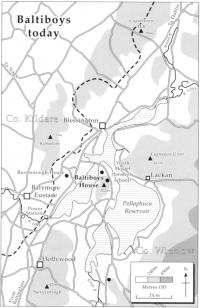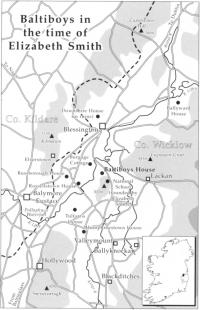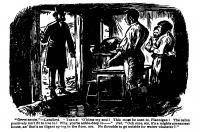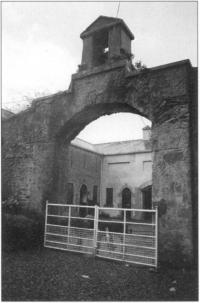Personal narratives as historical sources: the journal of Elizabeth Smith 1840-1850 (3:1)
Published in 18th-19th Century Social Perspectives, 18th–19th - Century History, Features, Issue 1 (Spring 1995), Volume 3Janet K. TeBrake

Baltiboys House today.
Among the many resources available for historical study and research on nineteenth-century Ireland are the numerous personal narratives by women, the most common form of writing women have traditionally produced. One of the earliest and best known of the genre is the diary of Mary Leadbetter. Another noteworthy example is the journal of Elizabeth Smith (1797-1885). Smith, a remarkably intelligent and articulate woman, kept a journal from 1840 until her death. A significant segment (1840-1850) has been published and is readily available. Like other journals and diaries compiled by women, it has been primarily read for pleasure or its literary value and has not yet received the scholarly attention from historians that it deserves.
In 1829 Elizabeth Grant, born and bred in Scotland, married Colonel Henry Smith of County Wicklow, who soon afterwards inherited Baltiboys, the small family estate. The couple had three children, Janey, Annie and Jack; Elizabeth stated that her purpose in keeping a journal was to provide guidance and instruction for her children, yet it offers much more.
Valuable for both biographer and social historian
The introspective aspect of the journal allows the biographer to learn about the life and personality of Elizabeth Smith. Her family, her daily activities, her goals and achievements, her concerns, and her opinions on numerous subjects, including politics, foreign affairs, religion, and the role of women, are all recorded in detail. Thus, the journal, along with her other publications, including the popular Memoirs of a Highland Lady, provide excellent material for a biography of this remarkable woman.
For the social historian Smith’s personal narrative is especially significant. Being an accomplished writer, she was able to express herself clearly on many subjects. She paid very close attention to detail and vividly recorded accounts of daily life on the Baltiboys estate. Her lengthy descriptions of what she saw around her are extremely valuable to anyone studying the social history of early nineteenth-century Ireland, especially the information she provides concerning the peasant community, landlord-tenant relations, and the Famine.
 The peasant community
The peasant community
Smith’s journal reveals much about Irish peasants during this crucial decade of change and disaster. Through her, the ordinary rural people and their experiences come to life. Her observations were, however, limited to one particular peasant community but what she discloses about life in Baltiboys can serve as a representative account of peasant life in early nineteenth-century Ireland generally. There are numerous entries in the journal concerned with the daily lives of the ordinary people—their living and working conditions, family relations, and marital practices are but a few of the aspects of peasant life which are illuminated. Her accounts reflect the heterogeneous nature of peasant society even before the Famine.
Of particular importance is the insight Elizabeth Smith provides into the lives and daily activities of peasant women. As mistress of Baltiboys, she had daily contact with her female servants, and, because she visited the tenants on a regular basis, she became well-acquainted with the wives and other female relations of the tenants and labourers. By recording her daily experiences with the Irish people, especially the women, and by relating episodes or stories about them, Smith’s journal in a vicarious fashion ‘speaks’ for Irish peasant women.
Landlord-tenant relations
Elizabeth Smith’s journal reveals much about landlord-tenant relations. A careful reading illustrates that they were of a complex and dynamic nature, ranging from loyalty and affection of varying degrees to dislike and bitterness. Especially noteworthy were the relations which developed between the mistress herself and peasant women and children. There were long-term relationships of fondness and loyalty like that which existed between Smith and old Peggy Dodson, her helper in many matters and, at times, her confidante. A more contentious but
 grudgingly respectful relationship of long standing formed between her and the rebellious Judy Ryan. She also developed close relationships with the peasant children of Baltiboys. For example, she tells us about Lachlan and Mary Ryan, the ‘abandoned’ children of Judy Ryan. We can follow their experiences through the journal, ending with their landlord-assisted emigration to America during the dark years of the Famine.
grudgingly respectful relationship of long standing formed between her and the rebellious Judy Ryan. She also developed close relationships with the peasant children of Baltiboys. For example, she tells us about Lachlan and Mary Ryan, the ‘abandoned’ children of Judy Ryan. We can follow their experiences through the journal, ending with their landlord-assisted emigration to America during the dark years of the Famine.
Smith’s interactions with the tenants on the Baltiboys estate were firmly based on her principles of duty and improvement, which caused her to take her role of mistress of the estate quite seriously and take a maternalistic interest in ‘her’ tenantry, servants, and labourers. She visited the Baltiboys tenantry to keep informed of their conditions and provided food, clothing, fuel, aid to the sick, and employment to the ‘deserving’ among them. She found homes for orphaned or abandoned children of tenants, provided for their upkeep, schooling, and later tried to find positions for them. Smith’s maternalism was embodied in the enlightened, modern notion of improvement which was basic to her philosophy of life: she would help those who helped themselves.
Want of education
Smith put much effort into the improvement of not only her family but also of the tenantry, primarily through her emphasis on education. She believed that a ‘proper’ education was one which would ‘improve the intellect (and) control the temper’ [5 March 1841]. She was convinced that a lack of a proper education lay at the root of all Ireland’s ills:
The more I think over the unhappy condition of the people of this country the more convinced I am that all their misery springs from the want of education, moral and intellectual, they get neither,  either in their homes or generally in their schools and I should say the higher ranks are very nearly as much in need of it in every point as the lower [27 July 1841].
either in their homes or generally in their schools and I should say the higher ranks are very nearly as much in need of it in every point as the lower [27 July 1841].
To remedy the situation Smith established a national school on the estate. She devoted much time to its management and to the supervision of the peasant children who attended it: ‘[I]s it not plain that properly educated they would be a fine and moral race’ [25 December 1840]. ‘The school is the foundation of all hope for their future. To waken up their faculties is the only dependence we can have for another generation of a happier kind’ [28 October 1845].
Her enlightened principles caused her to stress the vital importance of secular education devoid of any religious influence, especially the influence of Catholic priests. Smith saw the priests and the hedge-schools as hostile to her national school and to the principle of individual initiative and self-improvement. She often spoke of being at war with Father Germaine, the parish priest whom she said felt threatened by her school and her influence on the Baltiboys tenants.
Estate management
While carrying out her duties as the mistress of Baltiboys, Elizabeth Smith also played a major role in the management of the estate, and thus came into contact with its tenantry in another capacity. Although her husband, the acknowledged manager of Baltiboys, had the final say on larger policy issues, such as rents, leases, and evictions, she, aided by trusted agents and stewards, actually managed the estate on a daily basis. Early entries demonstrate how she combined her role of wife and mother with her role of manager of the estate. ‘In the morning I worked at accounts, paid all our debts; then gave Janey a music lesson’ [l January 1840]. ‘After mending Hal’s flannels I finished the year’s accounts—£6 odd remaining in hand’ [2 January 1840]. Was Elizabeth Smith unique in her role as manager of Baltiboys or was it a role assumed by more gentry women than commonly believed?
She roundly criticised, even condemned, the old system of Irish agriculture, and especially the irresponsibility and improvidence of the Irish landlords of Castle Rackrent days. These men and their old system were the cause, she said, of Irish poverty, and, she noted with great pride, that she and Colonel Smith had greatly improved Baltiboys since their arrival:
When I look back on the condition in which we found our pretty little property I can hardly believe that fifteen years should or could have worked out so improved a state of things. Land neglected, mud hovels ruined, farm offices wanting, proper fences unknown, meat seldom tasted, rags for clothing, all in debt, in dirt, in utter ignorance of everything; [sic] this is what met me that memorable day that Pat Lalor answered my inquiry as to who were all that mob of beggars, with ‘Thim’s the tinants’. Now we have larger farms, larger fields, some good fences, much finer cattle, a few sheep, even some turnips, five new slated houses, three of them two storeys high, good clothing, meal and bread and bacon and a ‘bit of beef by times’. Draining a rage, planting, clearing, good schools, a night school, lending library, and much approach towards cleanliness. Fifteen years more and what may we not hope for [28 October 1845].
 The Famine
The Famine
A major strength of Elizabeth Smith’s journal is what it reveals about the Great Famine. She kept a meticulous record of all aspects of the calamitous period, beginning in 1845 with the first sightings of the potato blight in the area and ending in 1850 when she optimistically noted that the Famine was subsiding. She shows us real human beings experiencing and responding to the Famine in a way that charts, tables, and figures, important in their own right, never can. Naturally, Smith’s own experiences of and responses to the Famine are most fully developed. Always faithful to the principle of improvement, she viewed the tragedy, at least initially, as a catalyst for change and a better future: ‘This visitation of providence will thus be the means of prosperity to our nation by bringing forward the help so much wanted without which we must have grovelled on for ages through turmoil and poverty and misery, and with which we may hope all of us of this generation to see plenty and comfort in the dear land’ [18 October 1846].
Despite her belief in its providential nature, however, Smith could not and did not stand idly by while the Famine raged. Her deep commitment to duty as the mistress of Baltiboys, as well as her compassion for all in distress, motivated her to labour tirelessly for those in need. It was during the terrible months of the Famine that she most clearly articulated what duty meant to her. ‘I have made up my mind that the distress of the poor demands a large sacrifice on the part of the richer, and it must be our business to prepare for this and to give up luxuries to meet this. “To feed the hungry” is a duty that cannot be shirked’ [29 November 1846].
Relief efforts
Smith’s journal offers hints of famine relief activities in general. We learn, for example, that she and her husband established their own programme of private relief for their labourers and the most distressed tenants of Baltiboys. By taking advantage of the British government’s drainage loans scheme, the people of Baltiboys were employed by the Smiths for as long as possible. A rather unique source of private famine relief was provided by Elizabeth Smith herself. To add to the relief fund and to bolster the household economy, she wrote and received payment for articles published in such prestigious journals as Chambers Edinburgh Journal.
We also learn that women played a particularly important role in famine relief efforts which were often divided along gender lines. For example, while gentry men managed relief efforts such as building roads, gentry women provided food and clothing for the destitute. She provides similar information for the peasant community. While it is generally known that men found employment in public works projects, Smith provides rare insight into the roles of women in particular. She writes of their attempts to provide food for their starving families. Begging, of course, was one way, but there were others. One entry reveals Smith’s encounter with a destitute woman trying to sell baskets to feed her hungry husband and children. Meanwhile, old Peggy Dodson, a pensioner of the Colonel and thus directly cared for by the Smiths, aided their efforts by selling food provided by them to other Baltiboys tenants, or by making soup for the labourers.
The poor law
The journal provides a personal perspective on the effectiveness of British government relief efforts. She expressed great dissatisfaction with the policies of Lord John Russell’s Whig government. The poor laws, she said, unfairly placed the heavy burden of paying for famine relief on the ‘good’ landlords such as her husband and public works schemes were inefficient and promoted idleness. True to her notions of improvement, however, she favoured both the drainage loan measures and the draconian Gregory clause of 1847. While one provided employment for the poor and improvement of the land, the other provided ‘improvement’ by forcing the small tenant farmers off the land, those whom she called ‘beggars and the true paupers of Ireland’ [8 April 1847]. She also saw Famine emigration as a means of both self-improvement for the departing Irish and as a means for the general improvement of the country.
Smith’s concentration on Famine events as they occurred in Baltiboys offers a microcosm of the Famine and its impact more generally. The journal breathes life into the facts and figures. One becomes familiar with actual people who lived (and in many cases, died) during the Famine. They begin to speak. Of course, historians must not become too sentimental, and must always exercise a certain degree of detachment, but the history of the Irish Famine is a history of human suffering. In this respect, the journal is an immensely valuable source.
Problems of interpretation
Although journals and diaries are valuable tools for writing social history, they present certain interpretative problems. Smith was a very opinionated woman who was also a member of the land-owning elite. Her journal is not only a personal view of her times, it also offers interpretations of events, people and the world around her that reflect her elite status. She speaks for those who cannot speak for themselves, but we will never know the exact feelings or opinions of those for whom she spoke. How did they truly view her frequent visits to their homes? Were they seen as the actions of a meddlesome landlady or were they, as she perceived, a welcomed event, a duty, or an expected obligation owed them? How did they feel about her efforts to improve them and their children?
Resistance
In fact many entries in the journal outline conversations between Smith and various tenants, labourers or servants, suggesting that ‘Lady’ Smith, though the acknowledged mistress of Baltiboys, did not always command absolute deference or obedience. Throughout her journal, Smith often displays outrage, frustration, and anxiety over the negative ways by which the peasants responded to what she saw as her duties and obligations or as her acts of kindness towards them. What she interprets as evidence of an inherent flaw in the ‘Irish character’ could also be judged as evidence of resistance to dominance and of a desire on the part of the peasantry to maintain some control over their own situations.
There were defiant demonstrations of resistance by even the most loyal of her tenants and servants, such as the withholding or late payment of rents (tenant Rutherford), breakage or shoddy work (many female servants), drunkenness (Paddy the gardener), displays of resentment, bitterness, exaggeration (Judy Ryan), and what Smith refers to as ‘fits of temper’ (Tom Darker and occasionally all Irish people—’Unhappy Ireland, how much have your wild children yet to learn? With such passions how are they ever to be raised into that pre-eminence their talents and their energy seem to have destined them to occupy’ [22 June 1842].).
Because she was a member of the Protestant elite and held such condescending views of the Irish people, it would be tempting to dismiss her journal as simply a defence or apology for landlordism. But one does not have to agree with Smith’s opinions and interpretations to appreciate the historical value of the journal. By careful reading and judicious reinterpretation, the historian can extract from it what is useful.
Janet K. TeBrake is a professor of British and Irish history at the University of Maine.
Further reading:
P. Pelly & A. Tod (eds.), The Highland Lady in Ireland: Elizabeth Grant of Rothiemurchus (Edinburgh 1991).
A. Tod (ed.), Memoirs of a Highland Lady by Elizabeth Grant Smith of Rothiemurchus [2 vols.] (Edinburgh 1988).
J.C. Scott, Domination and the Arts of Resistance: Hidden Transcripts (New Haven 1990).
















